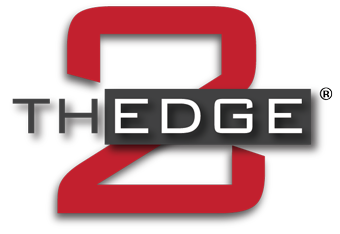WHITE PAPER
A Maturity Model for Transformative Innovation
What Is The Transformative Innovation Curve?
The Transformative Innovation Curve (“Curve”) is a maturity model 2THEDGE developed based on research and analysis from the collective experience of 2THEDGE’s subject matter experts. Each of the points on the Curve represents an approach to innovation.

Traditional Approaches
- Follow the Leader is one of the most expedited paths to innovation where the organization implements the industry leader’s solution or a best-selling option, tacitly presuming it is the best choice.
- The Research approach results from a search bounded usually by time and/or labor constraints.
- Benchmarking evaluates the “finalists” against an industry standard.
- Subject Matter Expertise relies on published research, analyst inquiries, or vendor product specialists as the basis for selection.
- With Demonstrations of Existing Solutions, a choice follows ascertainable results from testing off-the-shelf solutions.
Mature Innovation
- Discovery predicates the choice of a solution upon an initial discussion with the end users to define business needs.
- The Simulations/Models approach typically incorporates business needs from Discovery, along with a SWOT analysis.
- Collaborative Partnering occurs when stakeholders and sponsors formally agree to critical components such as scope, ROI, and/or budget.
- Agile Testing and Experimentation to Inform Capabilities is the accelerated testing and experimentation of vetted solutions against predetermined business needs from Collaborative Partnering.
- An Embedded Disruptive Innovation Practice is an institutionalized, on-going innovation cycle of strategic identification of business needs, discovery of capabilities, agile testing and experimentation, and implementation.
The innovation approach the organization chooses correlates directly to the business value it receives. As the organization moves from immature approaches (left side of the curve) to more mature ones (right side of the curve), the business value increases. At the far right of the curve, an embedded, sustained, and disruptive innovation cycle can yield extraordinary ROI (Figure 1). 2THEDGE has identified over $30 billion in cost avoidance/cost savings for clients to date.
Organizational Learning and Innovation
In today’s business context, innovation is nothing if it isn’t learning. There are two basic approaches to learning. The common learning model for children is pedagogy, a passive construct of one-way learning methods and techniques. Andragogy is an adult learning model that incorporates two-way learning (Figure 2).
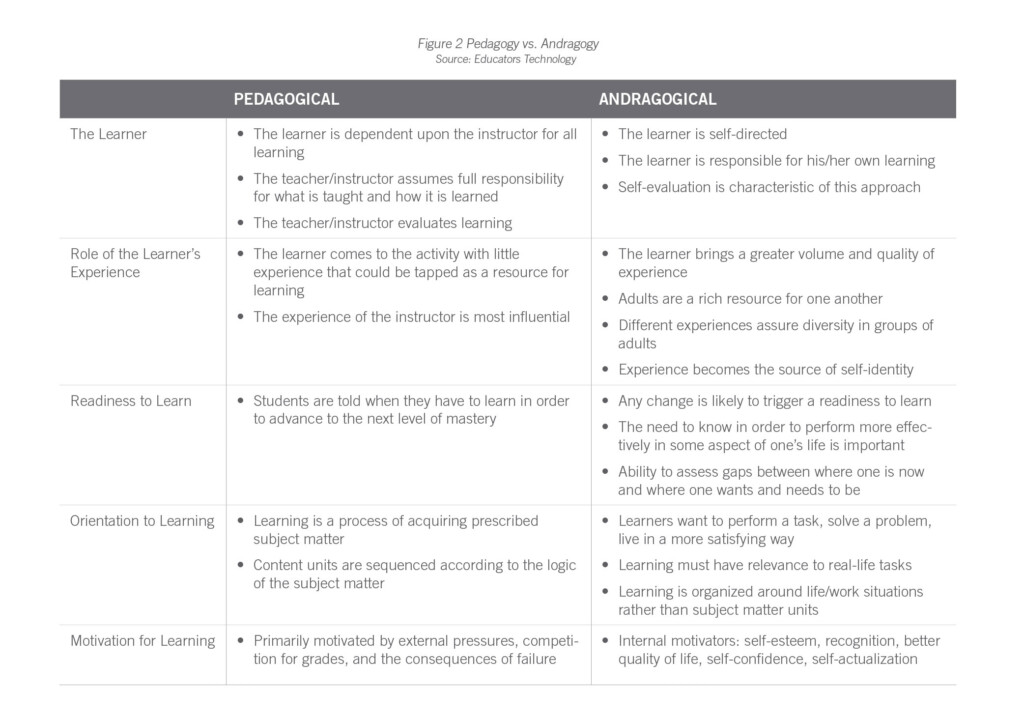
One-way learning occurs in a command and control environment where an instructor or trainer is responsible for conveying the content and manner in which participants learn it. Students’ experiences mostly are irrelevant because they have little or none in the subject matter. Two-way learning is static and presumes a shared responsibility where the instructor or trainer facilitates a dynamic discovery process and the participants’ shared experiences are at least as important, if not more so, than the facilitator’s.
If one were to analyze each approach to innovation on the Curve using learning theory, it becomes clear that Follow the Leader, Research, Benchmarking, Subject Matter Expertise, and Demonstrations of Existing Solutions are passive, or pedagogical, approaches to innovation. Traditional approaches rely on pre-determined parameters from one-way learning and existing solutions to inform the solution.
Discovery, Simulations/Models, Collaborative Partnering, Agile Testing and Experimentation to Inform Capabilities, and Embedded Disruptive Innovation are active, or andragogical, pursuits of innovation. Here, the solution does not rely on existing options. Two-way learning from testing and discovery informs both the process and the final selection. Figure 3 is an enhancement of the maturity model with learning theory considerations.
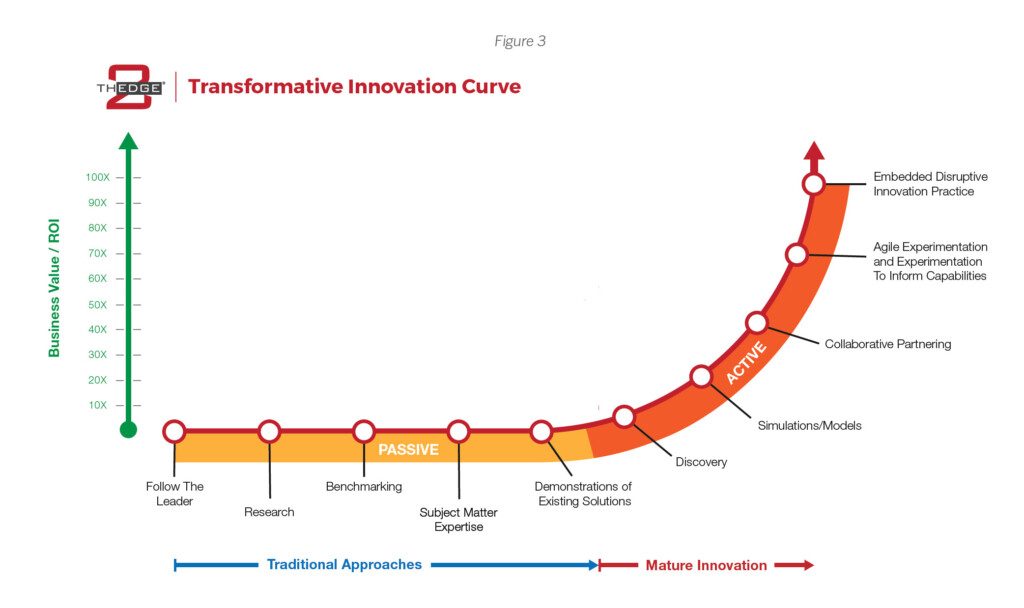
Decision-Making And Innovation
David Snowden presented the Cynefin decision-making framework in the 1980s as a “sense-making” model (Hammond). With sense-making models, data-gathering precedes the selection of a decision type; whereas, “categorization” models require a choice of decision-making methodology before data-gathering begins. A sense-making model like Cynefin fits perfectly into the learning construct for innovation.
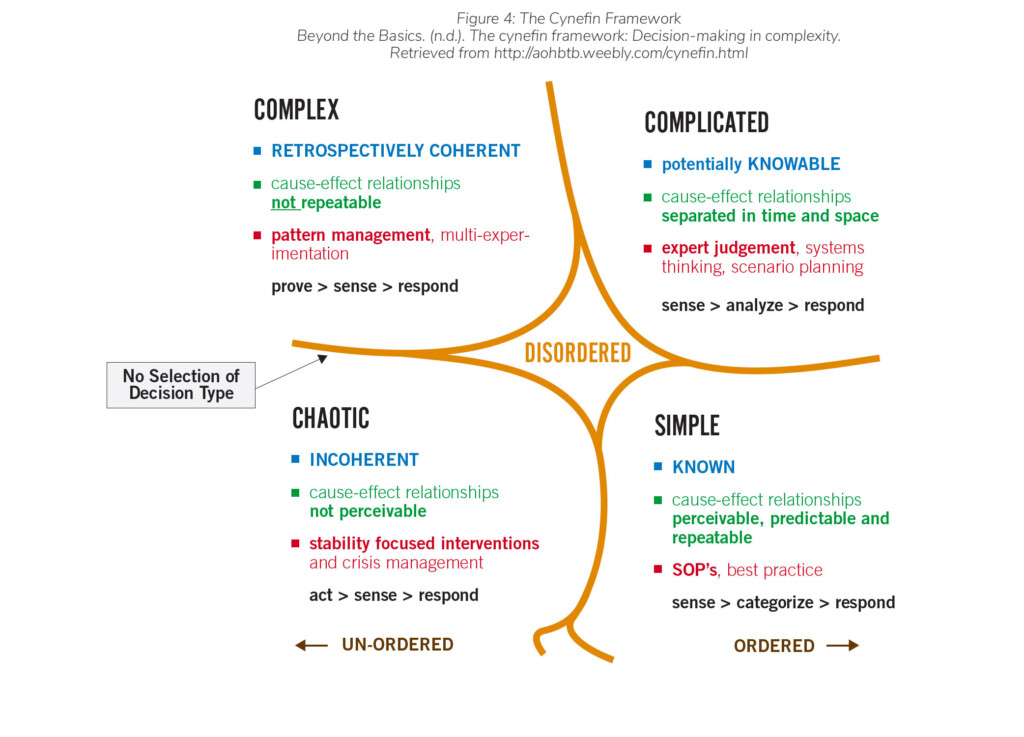
The framework presents four decision-making types. The two “ordered” ones are simple and complicated. The two “unordered” are complex and chaotic (Figure 4). The reference to “disordered” in the center represents a circumstance where the decision-maker is unsure which of the types applies. Existing technologies and perceivable results are not characteristic of disruptive innovation. Cynefin recognizes this in the dichotomy of ordered decision-making and unordered decision-making.
Ordered Decisions
Simple decisions acknowledge a cause and effect relationship that one can perceive and predict. Decisions follow from sensing the situation, categorizing it as simple, and initiating a rote response (Snowden). Simple decisions correspond to Follow the Leader, Research, and Benchmarking approaches on the Curve (Figure 1). These approaches to innovation rely on existing technology that has gone through the full development cycle with known capabilities. Consequently, the decision-maker can determine whether the technology is viable or not for a given use case easily.
Complicated decisions involve cause-effect relationships that are separated in space and time. These decisions require expert judgment, systems thinking, and scenario planning that follow from sensing, analyzing, and responding to the situation. Complicated decisions include Subject Matter Expertise and Demonstrations of Existing Solutions because these approaches to innovation rely on expert analysis and judgments.
Unordered Decisions
Causes and effects of Complex decisions are obvious in hindsight only and not repeatable. Outcomes of Complex decisions are unpredictable and require a probe, sense, and respond methodology. Discovery, Simulations/Models, and Collaborative Partnering are Complex decisions. They require advanced data gathering or ideation to define a use case.
Chaotic decisions can be deliberate or accidental and preclude perceivable cause and effect relationships. The response to chaos results from acting, sensing, and responding. Agile Experimentation to Inform Capabilities and Embedded Disruptive Innovation are chaotic decisions because they evolve from an urgent business need where market solutions often don’t exist, or where the viability of existing technology for a desired use case has not been tested.
Figure 5 enhances the maturity model further with the addition of decision-making considerations.
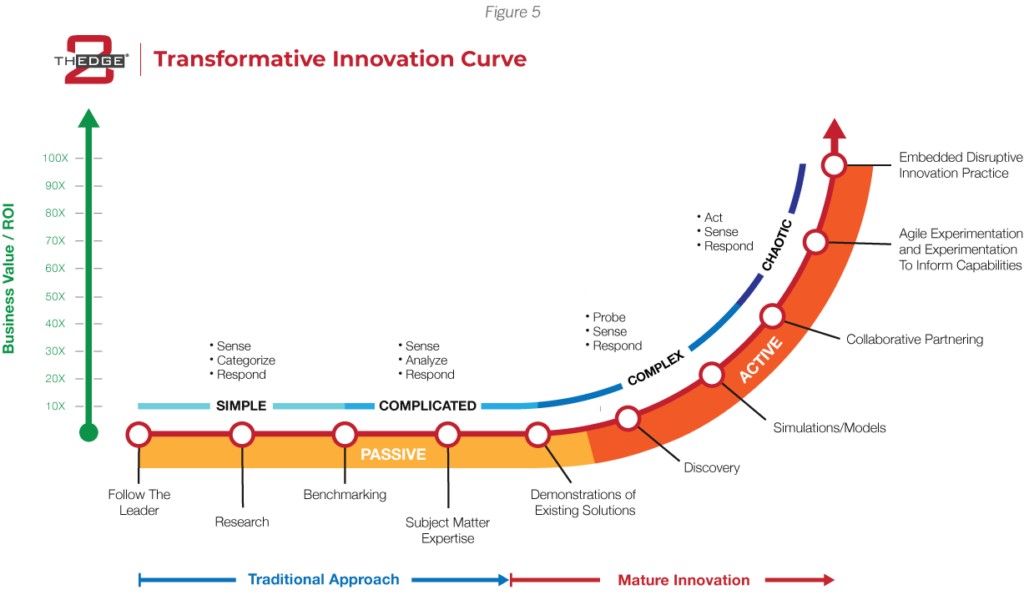
Technology Readiness Levels and Innovation
Technology Readiness Levels (“TRLs”) are a measurement system to assess the maturity of various technologies. There are 9 levels, with 1 the lowest and 9 the highest. The established parameters of each technology level, and the progress of the development process, determine the TRL (NASA). Figure 6 outlines the 9 TRL levels.

At TRL 1, research is beginning that will inform future development. TRL 2 occurs at the point when stakeholders determine that practical applications can result from the initial research findings. TRL 2 projects are speculative, as there is little or no experimental proof of concept for the technology. TRL 3 begins when active research and development studies suggest the technology is viable and ready to proceed through the development process. Often during TRL 3, a proof-of-concept model is developed.
TRL 4 is the proof of concept stage where multiple component pieces are tested with one another. A project advances to TRL 5 when rigorous testing in simulated environments as close to realistic as possible identifies the technology as “breadboard” – that is, a good candidate for prototyping. A project that utilizes fully functional prototypes or representative models is at TRL 6. Level 7 requires that the working model or prototype be demonstrated in a specific environment. After a successful demonstration that moves into implementation, the technology attains TRL 8. Finally, a successful, “flight proven” technology is at TRL 9.
2THEDGE works with technologies at levels 4 – 6 mostly, because its clients are organizations seeking a competitive edge from technology solutions. Those solutions at TRLs 7 – 9 are, or soon will be, existing technologies that competitors can obtain easily. Solutions in the TRL 1 – 3 range need a bit more definition for clients to assess viability.
Figure 7 adds additional color and context to TRLs with the inclusion of descriptors for the TRLs and typical timelines for development, testing, feasibility studies, initial operating capability (“IOC”) and full operational capability (“FOC”) determinations, and costs.

Figure 8 depicts the Transformative Innovation Curve with the congruence of experience, learning, decision-making, and technical readiness.

Summary
Predictable results from data-gathering, ordered decision-making, and existing solutions that are high on the Technology Readiness scale characterize less mature innovation practices. These include Follow the Leader, Research, Benchmarking, Subject Matter Expertise, and Demonstrations of Existing Solutions.
Mature innovation relies on two-way learning from robust testing and experimentation, decision-making free from dependencies on existing technologies, predictable results, and structured decision-making protocol. Discovery, Simulations/Models, Collaborative Partnering, Agile Testing and Experimentation to Inform Capabilities, and Embedded Disruptive Innovation are mature practices. An organization seeking a competitive edge:
- defines business value proactively;
- provokes innovation intentionally;
- learns from agile experimentation eagerly; and
- implements technology solutions confidently.
2THEDGE provides agile, full-circle transformation and enhanced revenue opportunities in partnership with clients to deliver real business value from emerging industry trends and technologies. 2THEDGE’s approach to harness disruptive trends fosters organizational agility for competitive advantage through seamless partnerships aligned to clients’ strategic objectives. For more information, message us at [email protected].

